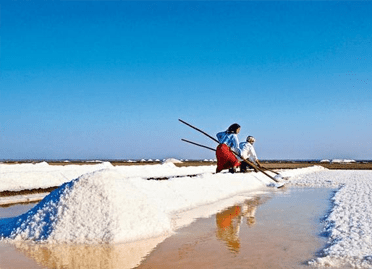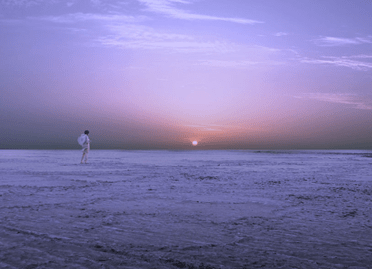Where am I : India Tour Packages » Most Popular Packages » Rann of Kutch Tour Packages
View Details

Destinations Covered : Delhi » Agra » Jaipur » Ahmedabad » Rann of Kutch
Visit in Rann of Kutch
The Rann of Kutch is a salt land in the Kutch district of western Gujarat. It covers about 30,000 sq km of land, including the Great Rann of Kutch. It is considered the largest salt desert globally. 'Ran' means desert in Hindi, derived from the Sanskrit word 'Irina,' which also means desert. The inhabitants of Kutch are called Kutchis and have their language of the same name. The majority of the population in the Rann of Kutch consists of Hindus, Muslims, Jains, and Sikhs. Here, you will learn all about the perfect tourist destination among the tourists located in Gujarat, which is especially famous for the White Desert and Rann Utsav. Let us know about the places to visit in Rann of Kutch.
The Rann of Kutch
The Rann of Kutch is the only white desert in India and one of the largest salt deserts in the world. The word Kutch in Sanskrit means island. It is related to the fact that the Rann of Kutch, the desert, was submerged in ancient times due to the Indus River flowing from here and joining the sea. Due to this, they got separated from the main area and drowned in shallow water-like islands. Due to an earthquake in 1819, the geographical landscape here changed, and the Indus River started flowing towards the west, and the Rann became a vast desert with salt particles. The ravines became flat swamps containing salts, and when their waters dry up in summer, they look as white as snow. Proving the presence of Kutch in ancient India, a fact is found that an island of Kutch named Khadir was found in Harappan excavations. The Rajput kings of Sindh ruled Kutch, but later Bhuj became the capital of Kutch during the time of Jadeja Rajput king Khengarji. Lakhpatji in 1741 AD during the Mughal period. He became the king of Kutch and ordered the construction of the famous Ajna Mahal. Lakhpatji respected writers, dancers, and singers, and during his reign Kutch made a lot of progress culturally. In 1815, the British captured the Bhujyo Dungar hill, and Kutch became an English district. Prague Palace, Ranjit Vilas Mahal, and Mandvi's Vijay Vilas Mahal were built in Kutch during the British rule itself. Due to being a royal state before being part of India on the independence of India.
Major attractions
Tourist Places in and around Kutch Ecologically important Banni grasslands are found on the outskirts of the Rann of Kutch. Large and small Ranns are found in the northern and eastern part of Kutch, surrounded by the Gulf of Kutch in the south and the Arabian Sea in the west. These ravines are marshy areas. Kandla and Mundra of Kutch ports are close to the Gulf and European countries for the sea route. The most commonly used language is Kutchi, but to some extent, Gujarati, Hindi, and Sindhi are also spoken. Many groups and communities live in Kutch. Migrants from the neighboring Mewar, Sindh, and Afghanistan regions came and mixed with the original inhabitants of Kutch, and these groups were formed. People visiting Gujarat must come here to experience this fantastic cultural diversity and the unique geographical landscape of the Rann of Kutch. There are many attractions to see in Kutch, in which the White Rann of Kutch is attracting tourists nowadays. Bhadreshwar Jain Tirtha and Mahadev's temple at Koteshwar and Narayan Sarovar, one of the holy lakes, are also worth visiting.
Bhuj: Capital of the Kutch region
It is the capital city of Kutch and is an excellent starting point for exploring the region. It is spread around a hill called Bhujia Dungar. Atop the hill is Bhujia Fort, built by King Rao Godaji to protect the city from intruders. Six major battles occurred after its construction, most of them during 1700-1800 AD and involving Muslim raiders from Sindh and Mughal rulers in Gujarat. Kutch Adventures India offers comfortable homestay accommodation in Bhuj. The owner Kuldip is a famous responsible travel guide, and you will be welcome in his family home. It is even possible to get cooking lessons from his mother. Alternatively, the Regenta Resort Bhuj is popular if you prefer more facilities. Otherwise, there are a variety of budget hotels on Station Road in the city center.
Kutch Desert Wildlife Sanctuary, Kutch
This is one of the most extensive periodic saline wetlands globally. Colloquially known as "Flamingo City," it is the largest wildlife sanctuary with a vast expanse. Situated near the submerged 5000-year-old Harappan civilization of Dholavira, the Kutch Desert Wildlife Sanctuary also cites various fossils. Apart from being a wildlife sanctuary, the sanctuary is also a fossil with many ancient dinosaurs, whales, and crocodile fossils. In addition to deep-sea creatures such as sea urchins and ammonites, there is also a range of fauna. These fossils are said to have been collected from the Dinosaur and Tertiary periods. The excessive salt deposits here give the sanctuary a pure white surface which attracts more uniqueness. However, since the Kutch Desert Wildlife Sanctuary is located on the Indo-Pak border, some sanctuary parts are restricted to the public. There are also some BSF areas.
A layer of salt
The Rann of Kutch is a salt desert with vast expanses of salt spread over large tracts of land by the Arabian Sea. Several salt deserts are found in the world, where the salt seems to have a darker texture in some places due to the strong presence of other minerals. Most of the Rann of Kutch, the Great Rann, is home to many villages located at its command. It is difficult to imagine life in an unfavorable environment such as a desert. Still, the people of Kutch have maintained tremendous cultural and gastronomic diversity. The flat expanses covering the ground with salt and other minerals form naturally as the salt settles with each tide from the Arabian Sea, which can be seen far on the horizon.
Hamirsar Lake, Kutch
This lake is located in the western end of Kutch, Gujarat. This lake is considered an oasis between the saline and dry Kutch. The kings built the lake in ancient times to meet the domestic needs of the people of Bhuj. It was well developed with a channel and tunnels that carried water from three rivers to fill the city's reservoirs. But after the 2001 Bhuj earthquake, this water system was severely distorted.
The municipality and the people of Bhuj once again took the initiative to revive the water system in its original form to meet the needs of its people. This achievement was achieved in 2003. The water of Hamirsar Lake had become potable. This artificial lake was named after the Jadega ruler Rao Hamir.
Mandvi Beach
It is a beautiful, pristine and serene beach. Apart from being a relaxing beach spot, Mandvi beach is famous for its camping and water sports facilities. Mandvi was not as severely affected by the 2001 earthquake as Bhuj, so many of its atmospheric old buildings are still intact. They can be seen strolling the narrow lanes around the market area. The Vijay Vilas Palace, faded by the beach on the outskirts of Mandvi, was the royal summer residence and can also be explored. Near Vijay Vilas Palace Estate in Bhuj, Mandvi Beach is a secluded and undiscovered beach destination with clear waters and a beautiful view. After a long walk along the shore as you watch the sunset on the horizon, or go bird watching and discover its beauty through the fauna of Kutch. Another activity here is the camel ride, which takes you on a tour of the entire property as you spin up and down on the back of this majestic animal or practice some yoga to the tunes of the gentle sea. It’s most appealing quality and serene surroundings make Mandvi Beach a charming meeting place with nature and beauty.
Camel and the moon
The spectacular Rann festival is the best way to witness the captivating beauty of the salt-encrusted land. The village of Dhordo, located on the edge of the India-Pakistan border, becomes the gateway to experiencing the Kutch Marshes. Days of festivals and music events showcasing local culture and cuisine paint the desert in the bright colors of Gujarat during the three winter months. It is by witnessing the moon's light as it lands on the saline land that the most stunning visual effect is observed. Something that the eyes could capture for a lifetime. Riding a camel on a whole moon night as you travel through a silvery land that offers an enchanting panorama.
Jain Temple
In Kode, long before Mandvi, an awe-inspiring white marble Jain temple exudes peace and tranquility. It has an impressive 72 temples dedicated to Jain deities. And most notable, the temple is relatively new, and it is possible to meet and hear the stories of the person responsible for carving it. The journey from Bhuj to Mandvi is fascinating, as the dry land turns into greenery and palm trees. It almost looks like South India!
Narayan Sarovar Temple
Known as the lake of Lord Vishnu, this place has five holy lakes. Narayan Sarovar is considered one of the most ancient and sacred pilgrimage sites of the Hindus. Temples of Shri Trikmaraiji, Laxminarayan, Govardhannathji, Dwarkanath, Adi Narayan, Ranchhodraiji, and Lakshmiji are attractive temples that can be seen here. The queen of Maharaj Shri Deshalji built these temples.
The Rann Utsav
Gujarat Tourism organizes a Rann Utsav festival, which begins in early November and continues till the end of February. Near the Gateway to Rann Resort, a tent city with hundreds of luxury tents has been set up with food and handicrafts stalls for the visitors. Sightseeing tours of nearby attractions are included in the price of the package. The activities included camel carriage rides, ATV rides, para motoring, rifle shooting, children's entertainment area, spa treatments, and cultural programs. Some people complain that it has spoiled the atmosphere. Ideally, plan to visit after the festivities are over if this is a concern.
Prag Mahal
The Prague Palace was built in 1865 by Raja Rao Pragmalji II. Hence this palace is known as Prague Mahal. This palace is built in the Italian Gautic style. Due to its beautiful architectural style, many Hindi films have also been suited here. This is a historical place where Rao Pragmalji started, and when the palace was completed, the rule of Rao Khengarji was going on.
Kutch Bustard Sanctuary
Locally known as Lala Prajan Sanctuary, the primary objective of the Kutch Bustard Sanctuary is to conserve the Great Indian Bustard. It is located in the Jakhau village of Naliya Taluka of Gujarat. There are three different types of bustards in the sanctuary among the wide other varieties of wildlife. Still, it has some unique species, including Harrier, Common Crane, Black Partridge, Sand Grouse, Black and Gray Francolin, Spotted and Indian Sandgrouse, Quail, Lark, Shrik, Corsair Are included. Plover, Imperial Eagle, Flamingo, Heron, Heron, Sandpiper, etc.
Vijay Vilas Palace
A summer palace named after Yuvraj Shri Vijayaraj, the heir to this kingdom, the Vijay Vilas Palace is one of the famous places in Kutch. Beautifully built of red sandstone, this palace houses some of the most delicate stone carvings and tile work. It is an exquisite work of artisans from different parts of India, reflecting the palace's religious aesthetics. Spread over 45 acres of land, this palace oozes royalty while offering splendid views. The palace has its beautiful private beach and air-conditioned accommodation where the royal family of Kutch State currently resides.
Kutch Villages and Handicrafts
The Kutch region of Gujarat is famous for the handicrafts produced by very talented artisans in its villages. Many famous arts originate from Pakistan, such as Bandhani tie-dye and Ajrakh block printing.
For handicraft tourism in India, Kutch is one of the top places. It is possible to visit villages and visit artisans independently. However, most do not speak English, and villages are scattered throughout the region, making them difficult to find. Each village of Kutch has its unique craft mastered by the people of this land of sheer artistry over the centuries. There is a wide variety of crafts ranging from weaving, patchwork, block-printing, bandhani, tie-and-dye, Rogan-art, and other ethnic embroideries to pottery, wood carving, and metal crafts, and shell-work.
Best Time to Visit Kutch
The history of Kutch is replete with centuries of artistic heritage, and its villages are living examples of its resilience to withstand the deadly 2001 earthquake. The geographical location makes Kutch a unique destination where you can find beaches, mountains, and white deserts. Come and explore Kutch, the land of the infinite horizon that tells stories. This area was once a vast shallow of the Arabian Sea until a continuous geological shift cut off the connection with the sea. Over the years, the area eventually became a seasonal swampy salt desert. During monsoon, the swamps fill with water, and the wetlands extend from the Gulf of Kutch in the west to the Gulf of Khambhat in the east. In summers, the water dries up and forms a craggy-based bed of salty white land.
How to Reach Kutch?
Local resorts will arrange transportation from Bhuj. There are some ways to get to Bhuj. Gujarat State Transport Corporation buses are available from Kutch to various places by road.
By train:
The main gateway to reach Kutch is Bhuj. Bhuj station is connected to Ahmedabad and various cities of Gujarat as well as New Delhi and the north-western and central parts of India.
By air:
Bhuj airport is the only major airport in Kutch. Indian Airlines, Jet Airways, Kingfisher, and flights of major airlines are available from this airport to various cities
By road:
Buses are available from many places around Gujarat, and the road is in good condition.
Where to stay
The most popular option is at Dhordo, the gateway to Rann Resort. It consists of characteristic Kutchi bhungas, traditionally made and decorated with handicrafts. Another recommended option is the Shaam-e-sarhad village complex in Hodka. The complex is owned and managed by residents. Both have attached bathrooms and running water, though hot water is only provided in buckets. Homestays are also available.
Conclusion
In ancient times, the Rann of Kutch, the desert, was submerged by the Indus River. Due to this, it got separated from the main area and submerged in water. Due to an earthquake, the geographical landscape of this region changed and the Indus River started flowing westwards, and the Rann became a vast desert with salt particles. There is also a saying about Kutch "If you haven't seen Kutch in Gujarat, you haven't seen anything." There are many famous places in Kutch. Most popularly, Kutch is known as the Rann of Kutch due to its marshy salt flats, which turn snow-white after seasonal waters that dry up the land during summer or winter. It is such a beauty that you cannot experience anywhere else; it is the sheer magnificence of this place that attracts tourists globally. The salt flats give it a dazzling look and seem like an endless stretch of land on the horizon with a different thrill. It is an excellent place for a weekend getaway visit in Rann of Kutch as it combines beauty and awe.
Speak to our Experts!
Instant Quote, Best Deals - 100% Customizable, Includes hotels + car + guides Cost depends on various factors like, number of people you are, travel dates, category of hotel and transportation etc.Drop your Inquiry to get the best deals as per your requirements. 100% Satisfaction Guaranteed. Rated 5* in TripAdvisor.




